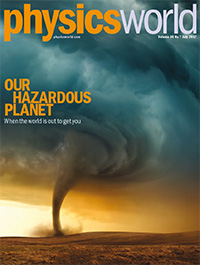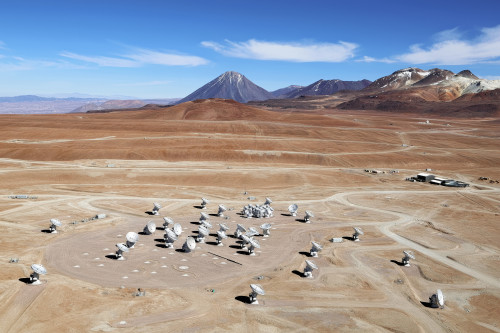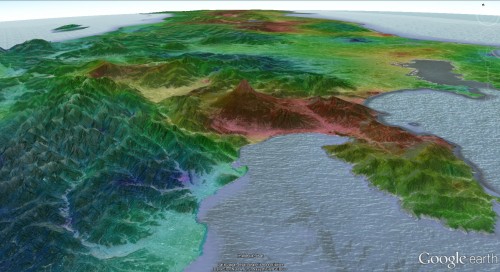Tag archives: volcano
Our hazardous planet: when the world is out to get you
 By Matin Durrani
By Matin Durrani
For people afflicted by last month’s devastating fire at Grenfell Tower in London or for those caught up in recent terrorist atrocities, it can seem that many problems in this world are entirely of our own making.
Yes the modern world has benefited from our collective wisdom and creativity – especially through science and engineering – but often it feels as if irrational human behaviour lies at the root of many of our troubles.
Nevertheless, we should remember that our planet itself holds many natural hazards too, as the latest special issue of Physics World reminds us.
Remember that if you’re a member of the Institute of Physics, you can read Physics World magazine every month via our digital apps for iOS, Android and Web browsers.
View all posts by this author | View this author's profile
Disaster-proof astronomy?

The Atacama Large Millimeter/submillimeter Array (ALMA) on the Chajnantor Plateau in Chile. (Courtesy: Clem & Adri Bacri-Normier/ESO)
By Louise Mayor in San Pedro de Atacama, Chile
In many ways, the Chajnantor Plateau in the Chilean Andes seems like one of the worst places in the world to build a very large and expensive telescope array. I have already experienced or witnessed first-hand a host of hazards on my trip to the Atacama Large Millimeter/submillimeter Array (ALMA), which is my reward for winning the European Astronomy Journalism Prize 2014.
At 2.39 a.m. local time last Monday, I was rudely reminded that I was in a tectonically active region by a magnitude-6.3 earthquake. At the time, I was staying overnight in Santiago, with two flights down and one to go on my way to the ALMA site in the Atacama Desert further north.
View all posts by this author | View this author's profile
Seismic study digs into volcanic plumbing

What lies beneath?: Mapping Mount Fuji. (Courtesy: Florent Brenguier)
By Tushna Commissariat
Plumbing problems do not get any bigger and more complicated than a backed-up volcano. But geophysicists looking at the responses of ground waves below Japanese volcanoes have now come up with a technique for identifying where pressurized volcanic fluids build up, allowing them to better anticipate when a volcano may erupt. Scientists already knew that seismic waves from large earthquakes agitate volcanic systems and that large eruptions generally follow a build-up of pressurized fluids at some depth. But they had been unable to pin down the specific physical changes that seismic waves cause. Now though, Florent Brenguier of the Institut des Sciences de la Terre in Grenoble, France, and colleagues at the University of Tokyo have used recordings of seismic-wave velocity from the devastating 2011 Tōhoku earthquake to create a map of seismic-velocity changes in its aftermath. Surprisingly, the largest changes were not observed in the area closest to the earthquake epicentre near the Pacific coast but farther inland, immediately below volcanic regions. The image above highlights an anomalously low seismic velocity below the Mount Fuji volcano after the earthquake, despite it being some 500 km from the epicentre. The drop in velocity is because the regions are susceptible to earthquake shaking – cracks in the crust open so that fluids at high pressures can escape, and could be seen as proxies for the high-pressure fluid build-up (Science 345 80).
View all posts by this author | View this author's profile
Icy spray from Saturn’s moon Enceladus sampled by Cassini

Cassini’s enhanced and false-coloured image of Enceladus backlit by the Sun shows the fountain-like plumes of the fine spray of material that spews from the south polar region (Courtesy: NASA/JPL/Space Science Institute)
By Tushna Commissariat
Enceladus, Saturn’s sixth largest moon is back in the news as the Cassini-Huygens mission has managed to directly sample the water plumes jetting into space from its southern polar region. These plumes of ice and salt originate from the moon’s famed “tiger stripes” region – four parallel giant fissures on the southern face of the moon.
The findings from these fly-throughs are the strongest evidence yet for the existence of large-scale saltwater reservoirs beneath the moon’s icy crust. “Enceladus is a tiny icy moon located in a region of the outer solar system where no liquid water was expected to exist, because of its large distance from the Sun,” says Nicolas Altobelli, ESA’s project scientist for the Cassini-Huygens mission. “This finding is therefore a crucial new piece of evidence showing that environmental conditions favourable to the emergence of life may be sustainable on icy bodies orbiting gas-giant planets.”
Indeed, the moon has been described previously by other Cassini researchers as one of the “most habitable spots beyond Earth in the solar system for life as we know it”.
Enceladus’ water plumes are though to contribute towards replenishing Saturn’s outermost and faint E-ring, which traces the orbit of Enceladus around Saturn. The Cassini spacecraft discovered the plumes in 2005 and more recently has been able to fly directly through them.
During three of Cassini’s passes in 2008 and 2009, its Cosmic Dust Analyser measured the composition of freshly ejected plume grains. The icy particles hit the detector target at speeds of 6.5–17.5 km/s, and vaporized instantly. Electrical fields inside the instrument then separated the various constituents of the resulting impact cloud for analysis.
Researchers looking at the data from the detector have found that grains ejected in the plumes and into the atmosphere of the moon and out towards the E-ring are relatively small and mostly salt-poor, closely matching the composition of the E-ring. However, closer to the moon itself relatively large, salt-rich ice grains were found.

This mosaic of 21 Cassini images is a false colour full-disc view of the anti-Saturn hemisphere on Enceladus (Courtesy: NASA/JPL/Space Science Institute)
Scientists explain this by saying that more than 99% of the total mass of ejected solids is in salt-rich grains, but most of these are heavy and fall back to the moon, so never make it into the E-ring. The salt-rich particles have an “ocean-like” composition which indicates that most, if not all, of the expelled ice comes from liquid saltwater body somewhere under the surface, rather than from the icy face of the moon.
The scenario envisioned by the team goes something like this – deep underneath Enceladus’ surface, perhaps 80 km down, there is a reservoir of water between the rocky core and the icy mantle, kept liquid by tidal forces generated by Saturn and its neighbouring moons, as well as by the heat generated by radioactive decay. When the outermost layer cracks open, the reservoir is exposed to space. The drop in pressure causes the liquid to evaporate, with some of it flash-freezing into salty ice grains: together these create the plumes.
When salty water freezes slowly, the salt is squeezed out, leaving pure water ice behind. So, if the plumes were coming from the surface ice, there should be very little salt in them. “There currently is no plausible way to produce a steady outflow of salt-rich grains from solid ice across the tiger stripes other than from saltwater under Enceladus’ icy surface,” says Frank Postberg, Universität Heidelberg, Germany, who is the lead author of a Nature paper announcing these results.